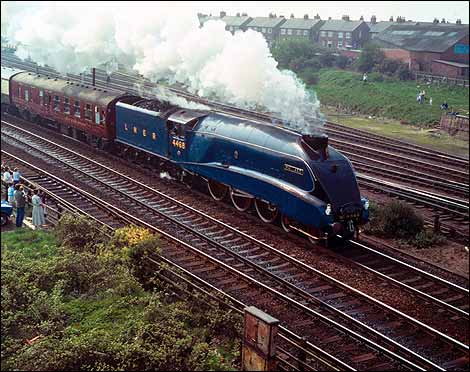Please tell me there is a reason why there is a need for a narrow gauge version of this loco tearing down the track of the CR&N.

Please tell me there is a reason why there is a need for a narrow gauge version of this loco tearing down the track of the CR&N.

Because you can?
tac
Ottawa Valley GRS
In 1889, a prototype of the Mallard type locomotive made a tour of the USA, looking for customers. Sensing a potential in the three foot gauge market, the Mallard was re-gauged to three feet, and ran successfully on the CR&N for six weeks.
Source: Southern North Idaho Junior College History Department.
Steve Featherkile said:
In 1889, a prototype of the Mallard type locomotive made a tour of the USA, looking for customers. Sensing a potential in the three foot gauge market, the Mallard was re-gauged to three feet, and ran successfully on the CR&N for six weeks.
Source: Southern North Idaho Junior College History Department.
Good one, Steve.
There were one or two narrow gauge streamliners. This is 750cm (2’ 6") in Russia.
(http://ngdiscussion.net/phorum/file.php?1,file=22824,in_body_attachment=1)
And there was a smaller version of the A4 streamlining, applied to a B17 4-6-0:

Hey, there’s a prototype for everything! Go for it.
Pete that Ruskie loco looks like a real life Marx Commodore Vanderbilt
Steve, the British loco was not a Mallard-Class loco. Many were named after birds of one kind or another.
I don’t know what the 1800’s Mallard-ype locomotive looked like.
tac
OVGRS
tac Foley said:
Steve, the British loco was not a Mallard-Class loco. Many were named after birds of one kind or another.
I don’t know what the 1800’s Mallard-ype locomotive looked like.
tac
OVGRS
TAC, are you doubting the History Department of the Southern North Idaho Junior College? Say it ain’t so. 
Steve Featherkile said:
In 1889, a prototype of the Mallard type locomotive made a tour of the USA, looking for customers. Sensing a potential in the three foot gauge market, the Mallard was re-gauged to three feet, and ran successfully on the CR&N for six weeks.
Source: Southern North Idaho Junior College History Department.
Steve, that is interesting. But since many narrow gauge railroads were short-line operations, and most narrow gauge track was not up to high speed travel, I have to wonder what kind of market there could possibly be for such a locomotive.
Some of the Maine two footers were too short to make high speed worth the trouble…the Monson was Known as the 2x6…two feet wide six miles long! The little Mallards would have traveled that line in something like 4 minutes…or ended up half a mile into the woods somewhere between stations!
David Maynard said:
Steve Featherkile said:
In 1889, a prototype of the Mallard type locomotive made a tour of the USA, looking for customers. Sensing a potential in the three foot gauge market, the Mallard was re-gauged to three feet, and ran successfully on the CR&N for six weeks.
Source: Southern North Idaho Junior College History Department.
Steve, that is interesting. But since many narrow gauge railroads were short-line operations, and most narrow gauge track was not up to high speed travel, I have to wonder what kind of market there could possibly be for such a locomotive.
David, see if you can find Southern North Idaho Junior College on Google. Devon only asked for justification to run one on his narrow minded railroad. 
Devon - to answer your original ? Because it’s beautiful!
Steve Featherkile said:
… Devon only asked for justification to run one on his narrow minded railroad.
Hey! I resemble that remark. 
Steve,
I love the reasoning. Great research. Southern North Idaho Junior College has a very well respected history dept. and if they say a mallard inspired narrow gauge ran the CR&N then it must be true. My guess is it would have been shortly after the NP take over.
There is a strong likelihood that it was built and the Baldwin Locomotive Works/ Wallace Division. I was planning on highlighting another build by the Wallace Division but this Mallard inspired streamline might have to come first.
I came across a CR&N timetable that makes a bit more sense now. It report that the “special” left Mission at 12:00 PM and arrived in Kingston 7 miles away at 12:05. and arriving at Wallace 27 miles away at 12:30 PM. An obscure article in the Wallace Free Press claims a locomotive was clocked at just under a 100 MPH. I couldn’t imagine at how this could be but in light of this new information I could believe it. Given the Mallards record breaking 126 MPH a 100 MPH narrow gauge doesn’t seem un reasonable.
I have a source that might just have a record of a supper secret build of an ultra fast stearmer being bult in and run in N Idaho.
We will have to se what comes of it.
 ROTFLMAO.
ROTFLMAO.
Devon, I’m glad that I could help out. You should see SNIJC’s research on griffins and unicorns, quite revealing.
You could always check out the Romney Hythe and Dymchurch railway site in the UK. This very long established timetabled 15" gauge line have a couple of locos based on Nigel Gresley’s earlier related A1 Pacific design. Suppose you could try to persuade them to clad one of these 1:3 replicas in a streamliner body. Might be abit tight for 1:1 maintanance persons to work on though. Max
I can definitely can see a 1:20.3 streamliner in my future. Loco. tender, combine, coach, and caboose. build it on 2-6-0 design like my avatar pic. I new there was a reason I was getting an extra set of wheels and tires.